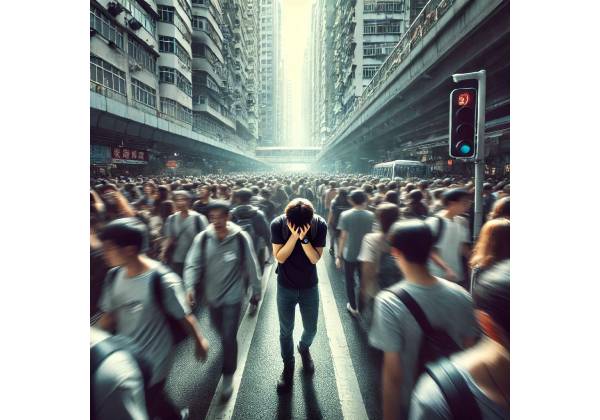
What is Enochlophobia?
Enochlophobia is a specific phobia defined by an intense and irrational fear of crowds. People with this condition frequently experience overwhelming anxiety when confronted with crowded environments such as shopping malls, concerts, or busy streets. While it is natural to be uncomfortable in large crowds, enochlophobia goes beyond that—people with this condition may go to great lengths to avoid crowded situations, even if it has a negative impact on their daily lives.
When confronted with a large crowd, people suffering from enochlophobia frequently feel trapped, unable to escape, or out of control. This phobia can significantly impair one’s ability to participate in social events, navigate urban environments, or attend public gatherings. Fear can also manifest itself in situations that do not appear directly threatening to others, such as standing in a line or taking public transportation during peak hours.
Living with enochlophobia can be extremely difficult because the fear of crowds frequently interferes with work, social relationships, and daily activities. Individuals can, however, effectively manage their fear and regain control of their lives with the right understanding, treatment, and support. In this guide, we will look at the symptoms, causes, and treatment options for enochlophobia in order to provide a comprehensive resource for those affected and their loved ones.
Symptoms of Enochlophobia
The symptoms of enochlophobia can appear in a variety of ways, affecting a person’s physical, emotional, and behavioral health. These symptoms usually appear in crowded environments or in anticipation of such situations.
Physical Symptoms
When someone with enochlophobia is confronted with a crowded space or even considers being in one, their body may respond with typical anxiety responses. These physical symptoms may include:
- Increased Heart Rate: When faced with the prospect of being in a crowd, many people experience a racing or pounding heart.
- Shortness of Breath: Many people feel as if they can’t catch their breath, which can lead to suffocation or chest tightness.
- Sweating: Excessive sweating, particularly on the palms and forehead, is a common physical manifestation of anxiety in crowded environments.
- Dizziness or Fainting: Increased anxiety can cause dizziness or fainting, particularly in small or confined spaces.
- Nausea or Stomach Discomfort: Fear and stress can cause nausea, a queasy stomach, or even gastrointestinal distress in a crowded environment.
- Trembling or Shaking: Many people who suffer from enochlophobia experience uncontrollable shaking or trembling when exposed to their phobic trigger.
- Panic Attacks: In more severe cases, enochlophobia can cause full-fledged panic attacks, which include symptoms such as hyperventilation, chest pain, or a sense of impending doom.
Emotional Symptoms
The emotional impact of enochlophobia can be severe, affecting the individual’s mental health and overall well-being. Emotional symptoms could include:
- Intense Fear or Panic: When thinking about or encountering crowded situations, people may feel paralyzed with fear.
- Anticipatory Anxiety: The mere thought of being in a crowded place can cause significant distress, even days or weeks before the event.
- Helplessness: Many people feel powerless when confronted with fear, believing there is no way to escape or control it.
- Shame or Embarrassment: People with enochlophobia may be embarrassed about their fear, especially if it interferes with their ability to attend social events or carry out daily activities.
- Irritability: Prolonged anxiety about crowds can cause people to become irritable, frustrated, or emotionally overwhelmed.
Behavioral Symptoms
Individuals with enochlophobia frequently exhibit noticeable behavioral changes as they avoid or flee crowded environments. These behaviors have a significant impact on the individual’s quality of life. Typical behavioral symptoms include:
- Avoidance of Crowded Places: Many people with enochlophobia avoid shopping malls, concerts, public transportation, and other congested areas completely.
- Leaving Situations Early: If forced to enter a crowded environment, people may leave abruptly or avoid staying any longer than necessary.
- Social Isolation: Over time, fear of crowds may cause people to withdraw from social gatherings, resulting in isolation and loneliness.
- Overplanning or Hypervigilance: People with enochlophobia may meticulously plan their outings to avoid busy times or crowded areas. This could include going shopping early in the morning, researching venues before attending, or only agreeing to events in less crowded areas.
Causes and Risk Factors for Enochlophobia
Although the exact cause of enochlophobia is unknown, it is thought to be a combination of psychological, environmental, and biological factors. Some of the main causes and risk factors are:
Psychological Causes
- Traumatic Experiences: A previous traumatic experience involving a crowd, such as becoming lost in a large group, being injured in a chaotic event, or witnessing violence or disorder in a crowded setting, is a common cause of enochlophobia. These experiences can leave emotional scars that lead to a persistent fear of similar environments.
- Conditioning: In some cases, enochlophobia can be caused by classical conditioning, in which a person associates crowds with negative feelings or experiences. For example, if someone has a panic attack in a crowd, they may develop a fear of crowded situations.
- Other Anxiety Disorders: Individuals with generalized anxiety disorder (GAD), panic disorder, or social anxiety disorder (SAD) may be more likely to develop enochlophobia. The fear of crowds may be combined with other anxiety-related fears, such as the fear of being judged or trapped.
Environmental Factors
- Cultural and Social Influences: Some cultures place a value on personal space or avoiding large gatherings. Growing up in such an environment may contribute to the development of enochlophobia, especially if the individual was taught that crowds are inherently dangerous or undesirable.
- Media Exposure: Media coverage of chaotic crowds, stampedes, or crowd-related accidents can exacerbate people’s fear of crowds, particularly those who are already anxious.
Biological and Genetic Factors
- Genetic Predisposition: People who have a family history of anxiety disorders or specific phobias may be more prone to developing enochlophobia. According to research, some people may have a genetic predisposition to anxiety, making them more susceptible to phobias.
- Neurochemical Imbalances: Imbalances in brain chemicals like serotonin and dopamine may contribute to the development of phobias, including enochlophobia. These imbalances can alter how the brain processes fear and stress, making some people more prone to anxiety.
How is Enochlophobia diagnosed?
An enochlophobia diagnosis requires a thorough evaluation by a mental health professional, such as a psychologist or psychiatrist. This process aids in determining the severity of the phobia and the most effective course of treatment.
Clinical Assessment
The clinician will begin by asking the individual about their previous encounters with crowds, any past trauma or anxiety, and how their fear affects their daily life. The clinician may also investigate whether other phobias or mental health conditions exist, such as social anxiety disorder or agoraphobia.
Symptom Evaluation
During the diagnostic process, the clinician will evaluate the individual’s emotional and physical reactions to crowded situations, as well as their avoidance behaviors. Standardized questionnaires, such as the Fear Survey Schedule (FSS) or the Specific Phobia Questionnaire, can be used to assess the severity of fear.
DSM-5 Criteria
To confirm a diagnosis of enochlophobia, the clinician will compare the patient’s symptoms to the criteria for specific phobias outlined in the **Diagnostic and Statistical Manual of Mental Disorders (DSM-5). The DSM-5 criteria include the following:
- A persistent, excessive fear of crowds that lasts six months or longer.
- The phobia causes significant distress or interferes with daily functioning, such as avoiding work, social events, or necessary activities due to a fear of crowds.
- The fear response is disproportionate to the actual danger posed by the crowd, and the individual is aware that their fear is irrational.
Treatment Alternatives for Enochlophobia
Treatment for enochlophobia usually consists of a combination of therapies, medication, and self-help strategies. The goal of treatment is to reduce the individual’s anxiety around crowds, teach them coping mechanisms, and help them regain control of their lives.
Cognitive-Behavioral Therapy (CBT)
Cognitive Behavioral Therapy (CBT) is a highly effective treatment for enochlophobia. CBT focuses on identifying and challenging the irrational thoughts that cause fear of crowds, and replacing them with more realistic, balanced ones.
- Cognitive Restructuring: In cognitive behavioral therapy, people work with a therapist to examine and reframe negative thoughts about crowds. For example, instead of thinking, “I’ll be trapped if I go into this crowd,” they learn that most crowds are safe and that they can leave if necessary.
- Exposure Therapy: A key component of CBT for enochlophobia is exposure therapy, in which individuals are gradually and systematically exposed to crowds in a controlled environment. Exposure usually starts with less anxiety-provoking scenarios, such as looking at pictures of crowded places, and then progresses to real-life exposure, such as attending a busy event. This gradually reduces the person’s fear.
- Coping Skills: CBT teaches people practical coping mechanisms like deep breathing, mindfulness exercises, and progressive muscle relaxation to help them manage the physical symptoms of anxiety when they are in crowds. These tools assist people in staying grounded, lowering their anxiety levels, and remaining in a situation for longer periods of time without panicking.
Acceptance & Commitment Therapy (ACT)
Acceptance and Commitment Therapy (ACT) is another therapeutic approach that has proven effective for treating specific phobias, such as enochlophobia. Unlike CBT, which focuses on changing negative thoughts, ACT encourages people to accept their anxiety and fear as normal parts of life, rather than attempting to eliminate or avoid them entirely.
- Mindfulness Techniques: ACT teaches people mindfulness techniques to help them stay present and observe their fear of crowds without feeling overwhelmed. Individuals who accept their anxiety without judgment can learn to tolerate their discomfort and take action in the face of fear.
- Values-Based Living: ACT encourages people to act on their values rather than their fears. For someone with enochlophobia, this could mean going to a social event or family gathering, even if the thought of being in a crowd makes them anxious. Individuals can make meaningful decisions by focusing on what is important to them rather than allowing their phobia to control their lives.
Medication
Medication is not always required to treat enochlophobia, but it can be beneficial in dealing with severe anxiety. Medications are frequently used in conjunction with therapy to provide temporary symptom relief, allowing people to participate more effectively in therapeutic interventions.
- Selective Serotonin Reuptake Inhibitors (SSRIs): SSRIs, like fluoxetine or sertraline, are commonly used to treat anxiety disorders and specific phobias. They help regulate serotonin levels in the brain, which can lower anxiety and improve mood.
- Benzodiazepines: For short-term relief during particularly stressful situations, benzodiazepines such as lorazepam or diazepam may be prescribed. These medications reduce anxiety quickly, but they should be used sparingly due to the risk of dependence.
Virtual reality exposure therapy (VRET)
Virtual Reality Exposure Therapy (VRET) is a new but effective treatment for phobias, including enochlophobia. VRET employs virtual reality technology to simulate crowded environments, allowing people to confront their fears in a controlled and safe environment.
- Gradual Desensitization: VRET enables people to experience increasingly difficult scenarios, ranging from mildly crowded virtual spaces to more intense environments such as concerts or festivals. This gradual exposure helps people become desensitized to their fears without the risks associated with real-world exposure.
- Enhanced Control: The therapist can adjust the virtual environment in real time to tailor the experience to the individual’s comfort level, making it a versatile and adaptable treatment option.
Self-Help Strategies
In addition to professional treatment, individuals with enochlophobia can use the following self-help strategies to manage their fear and regain control of their lives:
- Gradual Exposure: Gradually exposing oneself to crowds, beginning with less intimidating situations, can help reduce fear over time. This could entail beginning with a small group of friends before progressing to more crowded public areas.
- Relaxation Techniques: Deep breathing, meditation, or yoga can all help reduce overall anxiety and make it easier to deal with crowds when necessary.
- Support Networks: Creating a support system of friends, family, or support groups can provide motivation and accountability when dealing with crowds. Talking openly about your fears can help you feel less isolated and embarrassed.
Hypnotherapy
Hypnotherapy can be used as an additional treatment for enochlophobia. A hypnotherapist can help a person access their subconscious and address the underlying causes of their fear by guiding them into a deeply relaxed state.
- Relaxation and Visualization: Hypnotherapy frequently includes relaxation exercises and guided imagery to help clients reframe their fear of crowds in a positive light. This can help people confront their phobias in a less emotional state, making them easier to manage in real life.
Long-term Prospects for Enochlophobia
Most people with enochlophobia can make significant progress in managing their fear by combining therapy, self-help strategies, and, in some cases, medications. While complete phobia elimination is not always possible, treatment can reduce the severity of symptoms and improve quality of life, allowing people to participate more fully in social, professional, and public life. Long-term success requires regular therapy engagement, gradual exposure, and the use of coping mechanisms.










